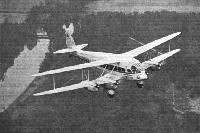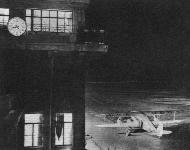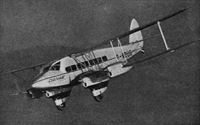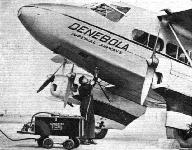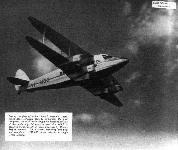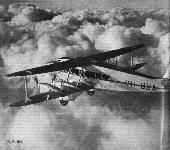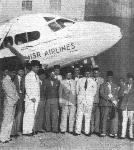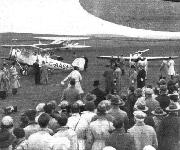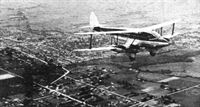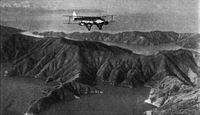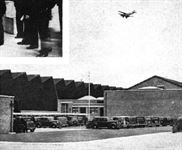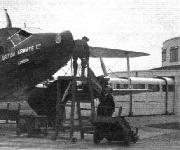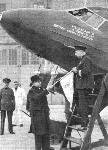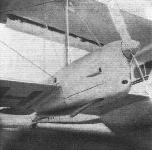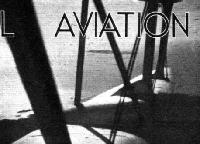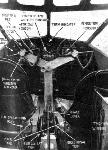
Описание
Страна : Великобритания
Год : 1934
Средний транспортный самолет с экипажем из двух человек
de Havilland DH.86
Разработанный и построенный в соответствии с требованиями правительства Австралии к многомоторному самолету для компании QANTAS (для полетов между Сингапуром и Австралией), DH.86 получил сертификат летной годности 30 января 1934 года - всего через четыре месяца после начала проектирования. Самолет представлял собой двухстоечный биплан деревянной конструкции с полотняной обшивкой и шасси с хвостовым костылем. Основные стойки, установленные под внутренними мотогондолами, были закрыты большими обтекателями.
Первый полет DH.86 совершил 14 января 1934 года. Прототип и вторая аналогичная ему машина были приспособлены под управление одним пилотом. Вторая машина с 21 августа 1934 года использовалась "Railway Air Services" для работы на линии Кройдон - Глазго, с промежуточными посадками в Бирмингеме, Манчестере и Белфасте. Второй член экипажа (штурман-радист) сидел позади пилота.
Компании QANTAS и "Imperial Airways" потребовали, чтобы оба члена экипажа сидели бок о бок, и в августе 1934 года фирма доработала прототип, удлинив и расширив носовую часть.
Первый из 29 серийных самолетов получила австралийская компания "Holyman Airways" (четыре машины). Также самолеты получили компании QANTAS (6), "Imperial Airways" (5), "Jersey Airways" (6), египетская "Misr Airwork" (4), "Hillmans Airways" (3) и "Wrightways" (1).
Варианты
DH.86A: этот вариант, созданный в 1935 году, отличался модифицированным ветровым козырьком, пневматическими амортизаторами шасси и хвостовой стойкой с колесом. Построили 20 самолетов, большая часть из которых была переделана в вариант DH.86B в 1937 году. RAF получили четыре самолета: два - школа радистов в Кранвелле и два - 24-я эскадрилья в Хендоне, другие машины были мобилизованы во время Второй мировой войны
DH.86B: конверсия DH.86A с концевыми шайбами на стабилизаторе, установленными после расследования катастрофы в Мартлешем Хит, происшедшей с одной из машин; вновь построенные DH.86B отличались горизонтальным оперением с законцовками увеличенной хорды и большими передаточными отношениями в проводке элеронов
ТАКТИКО-ТЕХНИЧЕСКИЕ ХАРАКТЕРИСТИКИ
de Havilland DH.86B
Тип: средний транспортный самолет с экипажем из двух человек
Силовая установка: четыре рядных двигателя de Havilland Gipsy Six мощностью по 200 л.с. (149 кВт)
Летные характеристики: максимальная скорость на оптимальной высоте 267 км/ч; крейсерская скорость на оптимальной высоте 229 км/ч; начальная скороподъемность 690 м/мин; потолок 5305 м; дальность полета 1287 км
Масса: пустого 2943 кг; максимальная взлетная 4649 кг
Размеры: размах крыльев 19,66 м; длина 14,05 м; высота 3,96 м; площадь крыльев 59,55 м2
Полезная нагрузка: до 19 пассажиров в закрытой кабине
Все четыре двигателя DH.86 были установлены в ряд на передней кромке нижнего крыла.
Описание:
- de Havilland DH.86
- Flight, February 1934
SPEED WITH SAFETY
Фотографии
-
Aviation Historian 40 / P.Marson - Southern charm
Регистрационный номер: G-ACZP [4] A rare colour portrait of the last surviving D.H.86B, G-ACZP (c/n 2321), resplendent in its distinctive Hampshire Aeroplane club colour scheme at the Kidlington sales weekend in April 1958. The aircraft had been impressed into Royal Navy service as AX843, but it was not taken up and was operated by Railway Air Services.
-
Flight 1934-01 / Flight
SPEEDING-UP BRITISH AIR TRANSPORT: The de Havilland D.H.86 can be regarded as a high-speed development of the "Dragon," from which it differs in having four engines and very tapered wings. The machine has not been through the Martlesham tests yet, and no official performance figures are, therefore, available, but one only has to see it fly to realise that it is very fast indeed.
-
Aeroplane Monthly 1984-04 / A.Lumsden, T.Heffernan - Probe Probare (3)
The prototype D.H.86 being flown from Stag Lane in January 1934 by Hubert Broad, just a few days after its first flight.
-
Aeroplane Monthly 1985-01 / J.Stroud - Wings of Peace
The prototype D.H.86 G-ACPL flying as E.2. The undercarriage fairings were soon redesigned.
-
Flight 1934-02 / Flight
This three-quarter front view gives a good idea how neatly the engines are faired into the bottom wing.
-
Aviation Historian 13 / D.Crotty - The Singapore Express
The prototype D.H.86 “Express Air Liner” with its B Conditions registration E.2 around the time of its first flight in January 1934, a mere four months after the decision was taken to proceed with the design. Note the original single-pilot “Roman” nose. Later examples were fitted with dual controls and a revised longer nose profile.
-
Flight 1934-02 / Flight
The foreshortening effect of this side view makes the "Express Air Liner" look somewhat ugly, but in point of fact this is far from the case, largely due to the heavily tapered wings.
-
Flight 1934-02 / Flight
The view shows the general cleanliness and tapered wings.
-
Aeroplane Monthly 1974-02 / B.Martin - Britain's civil aircraft register
Регистрационный номер: G-ACPL [5] The prototype D.H.86 flying from Hatfield in September 1934, bearing the civil registration letters G-ACPL.
G-ACPL was the prototype de Havilland D.H.86, and it was first flown from Stag Lane by Hubert Broad on January 14, 1934, its C of A being granted on January 30. Later that year the aircraft was delivered to Railway Air Services Ltd at Croydon. It was later re-built as a 2 crew aircraft and joined the imperial Airways fleet, where it was named Delphinus. In December 1941 it was impressed into RAF service at Cairo and carried service number HK844. -
Flight 1934-07 / Flight
Регистрационный номер: G-ACPL [5] FOR IMPERIAL AIRWAYS: The D.H. 86 Delphinus, with four "Gipsy Six" 200-h.p. engines.
-
Aeroplane Monthly 1974-04 / P.Moss - Wings for the Empire (4)
Регистрационный номер: G-ACPL [5] D.H.86, G-ACPL, Delphinus, before conversion to dual control.
-
Flight 1936-06 / Flight Advertisements
Регистрационный номер: G-ACVY [2] -
Flight 1934-08 / Flight
Регистрационный номер: G-ACPL [5] CRUISING AT 145 M.P.H.: One of the D.H.86's which are being used on Railway Air Services' Glasgow run, photographed near Hatfield. The "Diana" class is probably the fastest four-engined commercial machine in the world.
-
Aeroplane Monthly 1985-01 / J.Stroud - Wings of Peace
Регистрационный номер: G-ACPL [5] Railway Air Services’ D.H.86 G-ACVY Mercury over Hatfield Park in 1934. This was the third D.H.86 and retained its short nose throughout its working life.
-
Aviation Historian 13 / D.Crotty - The Singapore Express
Регистрационный номер: VH-URN Despite QEA's input into the design of the D.H.86, the first example in Australia was the first production machine, the single-pilot VH-URN, named Miss Hobart, for Holyman’s Airways, which was delivered in July 1934. The aircraft operated between Melbourne and Hobart on Tasmania until it was lost in the Bass Strait that October.
-
Flight 1935-05 / Flight
A section of the long line of machines on exhibition. In the foreground is the B.A.C. "Drone," then a Spartan "Cruiser," a Railway Air Services D.H.86, the K.L.M. Douglas D.C.2, and others.
Другие самолёты на фотографии: Douglas DC-1 / DC-2 / C-32 / C-39 - США - 1933Kronfeld Drone - Великобритания - 1932Spartan Cruiser - Великобритания - 1932
-
Aeroplane Monthly 1994-11 / H.Morris - Imperial adventurer (3)
Регистрационный номер: G-ACWC [7] G-ACWC Delia, one of the two Imperial Airways D.H.86s used on the Khartoum-Lagos route in 1936-37, for which the author doubled as flight and ground engineer in addition to acting as steward and looking after the food for crew and passengers.
-
Aeroplane Monthly 1994-12 / H.Morris - Imperial adventurer (4)
Регистрационный номер: G-ACWC [7] D.H.86 Delia in service on the Khartoum-Accra route. G-ACWC, one of the first of the two-crew D.H.86s, joined Imperial Airways in March 1935.
-
Aeroplane Monthly 1994-11 / H.Morris - Imperial adventurer (3)
Регистрационный номер: G-ACWC [7] D.H.86 Delia being serviced at Khartoum in the only hangar on the trans-African route in 1936. Note the Imperial Airways coach in the background.
-
Air-Britain Archive 1983-02
Регистрационный номер: G-ACWC [7] The photograph which comes to us via Roderick Simpson, may raise a few comments from readers. The back of the print is merely marked "In the grill-room at Khartoum" and is undated. In the foreground is Whitney Straight HB-EPI c/n 349 and facing the camera is "Delia" the Imperial Airways DH.86 G-ACWC c/n 2304. The presence of the DH.86 enables us to date the photo between 1935 and 1941, can anyone be more accurate? Perhaps the purpose of the Straight's visit is also known - part of a long distance flight perhaps? The structure between the two aircraft also raises some editorial doubts - is it a partly complete hangar? a wind-break? an early attempt at damming the Nile?? There could almost be a prize for the best answer, but surely there are readers with knowledge of pre-war or wartime Khartoum who can reveal the truth.
Our photo of Whitney Straight HB-EPI (83/30) has been accurately identified. The aircraft was owned by Dr. Kurt Tschudi who flew it in February 1938 from Bergamo to North Africa, up the Nile Valley, across the southern Sahara and back via the north coast. Tschudi had made a shorter trip previously in a Luscombe Phantom and took delivery of HB-EPI in 8.37. B.A.Clarke and P.E.Skinner tied down the facts but apart from 'a giant sun-shade and wind-break' the large structure in the photo is still unidentified.Другие самолёты на фотографии: Miles Whitney Straight / M.11 - Великобритания - 1936
-
Aeroplane Monthly 1994-12 / H.Morris - Imperial adventurer (4)
Регистрационный номер: G-ACWC [7] Changing the port inner D.H. Gipsy Six engine of D.H.86 G-ACWC Delia at Khartoum. Because of insufficient space in the hangar, which was often occupied by one of the company’s H.P.42s, this kind of task was often undertaken in the open.
-
Aeroplane Monthly 1994-12 / H.Morris - Imperial adventurer (4)
Регистрационный номер: G-ACWC [7] Imperial Airways’ D.H.86 Delia about to leave Croydon, possibly to join Daedalus on the African route in late 1936.
-
Aeroplane Monthly 1994-12 / H.Morris - Imperial adventurer (4)
Регистрационный номер: G-ACWC [7] Imperial Airways’ D.H.86 Delia is seen here at Croydon before it was transferred to the Africa route in 1936.
-
Jane's All the World Aircraft 1938 / 01 - The progress of the world in civil aviation during the year 1937-38
Регистрационный номер: G-ACWD [3] BUSINESS AS USUAL. - The disturbed state of China under Japanese invasion has not affected the regularity of the Imperial Airways service. The "Dorado," here seen at Kai Tak Aerodrome, Hong Kong, connects every week in each direction with the main Imperial route at Penang, 1,600 miles away. The flags are painted on wing and rudder for information and guidance of belligerent pilots.
-
Aeroplane Monthly 1974-04 / P.Moss - Wings for the Empire (4)
Регистрационный номер: G-ACWD [3] FAR EAST TERMINUS: The Imperial Airways D.H. 86 Dorado at Hong Kong after two years service on the Penang - Hong Kong service. From now on this service will cut across from Bangkok, thus shortening the flying distance. The Union Jacks painted on the fin and the wings are an efficient commentary on the present Far East situation.
-
Flight 1935-10 / Flight
Регистрационный номер: G-ACWD [3] TOWARDS HONG KONG: The Imperial Airways D.H.86 Dorado at Penang. On the left can be seen the four members of the crew, including Capt. W. Armstrong. Third from the right is Major R. L. Nunn, the D.C.A. for Malaya.
-
Flight 1935-02 / Flight
Регистрационный номер: G-ACYF [4] Giffard Bay, on the beach at St. Helier, with three of the service "Dragons" in the background. This picture was taken immediately after landing and before the inevitably large crowd collected.
Другие самолёты на фотографии: De Havilland Dragon Rapide / Dominie / D.H.89 - Великобритания - 1934
-
Air Enthusiast 2000-11 / G.Warner - Founding Fathers (2)
Регистрационный номер: G-ACZN [2] Jersey Airways DH.86 G-ACZN 'St Catherine’s Bay'.
-
Flight 1936-04 / Flight Advertisements
Регистрационный номер: G-ACZN [2] One of JERSEY AIRWAY'S large fleet of D.H.86's.
-
Air Pictorial 1956-05 / Photo-review
Регистрационный номер: G-ACZP [4] The only example of a four-motor biplane still flying is G-ACZP (Lancashire Aircraft Corpn.), a 1934-vintage de Havilland D.H.86A, now used for charter and joy-riding at Blackpool.
-
Air-Britain Archive 1981-03
Регистрационный номер: G-ACZP [4] The last DH.86 G-ACZP remained in service on the Lancashire Aircraft Corporation route from Blackpool to the I.o.M. until at least 1956 when this shot of "The Pig", as it was affectionately known, was taken at Ronaldsway.
-
Aviation Historian 40 / P.Marson - Southern charm
Регистрационный номер: G-ACZP [4] Rapide G-AHPU (c/n 6963) was acquired by Bellamy in January 1957 from Luton Flying Club, and was modified to Mk 4 standard in January 1958. It is seen here in the Hampshire Aeroplane Club’s Eastleigh hangar just after being repainted in the club’s new red, yellow and black scheme. Note D.H.86 G-ACZP in the background.
Другие самолёты на фотографии: De Havilland Dragon Rapide / Dominie / D.H.89 - Великобритания - 1934
-
Flight 1935-06 / Flight Advertisements
Регистрационный номер: G-ADCM -
Flight 1935-10 / Flight
Регистрационный номер: G-ADCN [4] Imperial Airways D.H.86 Daedalus on the Croydon tarmac under the new floodlighting. The line in the background is the black and white boundary fence.
-
Aeroplane Monthly 1994-11 / H.Morris - Imperial adventurer (3)
Регистрационный номер: G-ADCN [4] The delivery of the first airmail at El Fasherin February 1936. Capt O.P. Jones, centre, piloted this flight, but thereafter the service was taken over by Capt Taylor, 1st Off (later Capt) Cass and the author as flight engineer.
-
Aeroplane Monthly 1994-11 / H.Morris - Imperial adventurer (3)
Регистрационный номер: G-ADCN [4] Refuelling D.H.86 Daedalus at Kano, Nigeria, in 1936.
-
Aeroplane Monthly 1994-11 / H.Morris - Imperial adventurer (3)
Регистрационный номер: G-ADCN [4] Stratis, the ever-smiling Greek “Man Friday” at El Geneina, standing in front of D.H.86 G-ADCN Daedalus.
-
Aeroplane Monthly 1979-10 / Croydon /Gone but not forgotten/ (5)
Регистрационный номер: G-ADEA [3] British Airways D.H.86 G-ADEA surrounded by smaller fry, with two D.H.83 Fox Moths in the foreground.
Другие самолёты на фотографии: De Havilland Fox Moth / D.H.83 - Великобритания - 1932
-
Flight 1935-06 / Flight
Регистрационный номер: G-ADEA [3] HILLMAN'S BIGGEST: The first of the three D.H. 86 machines ordered by Hillman's Airways for their Paris service taken by a Flight photographer while it was flying above the clouds near Hatfield. This machine is fitted with full dual control though the later 86 's will have the swing-over type.
-
Flight 1936-04 / Flight Advertisements
Регистрационный номер: G-ADEA [3] BRITISH AIRWAYS operate many D.H.86's.
-
Aeroplane Monthly 1974-10 / P.Moss - British Airways (1)
Регистрационный номер: G-ADEB [4] Hillman's D.H.86A G-ADEB. The Air Mail crest is visible just forward of the registration letters.
-
Aeroplane Monthly 1984-04 / A.Lumsden, T.Heffernan - Probe Probare (3)
Регистрационный номер: G-ADEB [4] D.H.86A G-ADEB again, this time in British Airways livery. Photographs was taken at Gatwick before the aircraft was modified to D.H.86B standard.
D.H.86 G-ADEB of British Airways Ltd crashed near Altenkirchen in Germany on August 12, 1936. -
Flight 1936-06 / Flight
Регистрационный номер: G-ADEB [4] The general appearance of the terminal building with its retractable gangways is well shown in this view. A British Airways' D.H.86 has just come in from Scandinavia.
-
Flight 1936-07 / Flight
Регистрационный номер: G-ADEB [4] NIGHT MAIL: This country's first real night mail service was opened by British Airways on Monday. Leaving Gatwick at 10 o'clock, the mails reach Stockholm at 8.20 on the following morning. For the moment they are carried by A.B. Aerotransport from Hanover.
-
Aeroplane Monthly 1983-09 / J.King - From Little Acorns
Регистрационный номер: G-ADEC [2] D.H.86 G-ADEC after transfer to British Airways from Hillman's in June 1936, on the tarmac in front of the recently completed Beehive.
-
Aeroplane Monthly 1976-03 / Personal album
Регистрационный номер: G-ADEC [2] This view of Croydon in 1938 shows British Airways' D.H.86A G-ADEC nearest the camera. This aircraft began life in 1935 with Hillmans Airways, and was absorbed into British Airways the following year. Shortly after this photograph was taken 'EC was sold to Uruguay as CX-AAH. The centre aircraft of the group is KLM's DC-2 PH-AKH, Haan, with Air France's three engined Wibault Penhoet F-AMHM in the background.
Другие самолёты на фотографии: Douglas DC-1 / DC-2 / C-32 / C-39 - США - 1933Wibault Wibault 280 - Франция - 1930
-
Flight 1936-05 / Flight Advertisements
Регистрационный номер: G-ADMY [5] British Continental Airways' D.H.86A G-ADMY, St. George
-
Flight 1937-06 / Flight Advertisements
Регистрационный номер: G-ADMY [5] -
Flight 1936-05 / Flight
Регистрационный номер: G-ADMY [5] FLYING AT ITS BEST: British Continental Airways' D.H. 86 above the clouds in Surrey. Very shortly this company will be taking delivery of the first pair of four 86As, which will be fitted with Marconi two-way radio and a specially long fixed aerial. Lorenz short-wave receiving equipment will also be installed and all the instruments will be calibrated in the metric system.
-
Aeroplane Monthly 1974-10 / P.Moss - British Airways (1)
Регистрационный номер: G-ADMY [5] A D.H.86A G-ADMY, St. George, of British Continental Airways.
-
Flight 1936-05 / Flight
Регистрационный номер: G-ADMY [5] Все четыре двигателя DH.86 были установлены в ряд на передней кромке нижнего крыла.
-
Air-Britain Archive 1980-01
Регистрационный номер: G-ADUE Probably the best-looking of the biplane airliners was the DH.86. G-ADUE "Dardanus" of Imperial Airways posed at Hatfield on 23.3.37 and illustrates our article on C of A Applications.
-
Flight 1936-02 / Flight
Регистрационный номер: G-ADUG [3] FOR IMPERIAL SERVICE: The first of the new D.H. 86A's which are being built for Imperial Airways. machines are not fitted with v.p. airscrews.
-
Flight 1939-06 / Flight
Регистрационный номер: G-ADUG [3] The D.H. 86, a type first commissioned by Imperial Airways in May, 1934, for economical medium capacity work, and used also by Qantas Empire Airways for their section of the trunk route from 1934 to 1938.
-
Flight 1936-04 / Flight Advertisements
Регистрационный номер: G-ADUG [3] An IMPERIAL AIRWAYS D.H.86 Express Air Liner.
-
Flight 1936-05 / Flight
Регистрационный номер: G-ADYC BROMMA IN ACTION: Transport machines of three nations at Stockholm's airport. On the ground are a British Continental Airways' D.H. 86A and a Breguet-Wibault of Air France, while in the air is the Von Hindenburg, one of D.L.H.'s two Junkers G.38s, which have Jumo diesel engines.
Другие самолёты на фотографии: Junkers G 38 - Германия - 1929Wibault Wibault 280 - Франция - 1930
-
Flight 1936-11 / Flight
Регистрационный номер: G-ADYG Popular De Havilland biplane: the 86a transport machine with four Gipsy Six engines
-
Aeroplane Monthly 1984-04 / A.Lumsden, T.Heffernan - Probe Probare (3)
Регистрационный номер: G-ADYH D.H.86A G-ADYH at A&AEE during trials in July 1936.
-
Flight 1936-08 / Flight Advertisements
Регистрационный номер: G-ADYJ -
Flight 1940-09 / Flight
Регистрационный номер: G-AEAP Products of 1934. The D.H.86 commercial biplane.
-
Flight 1936-07 / Flight
A Dagenite ground-starting trolley in use by Imperial Airways. Its twelve-volt batteries are capable of 489 10-second "starts" at 100 amperes on one charge.
-
Flight 1936-04 / Flight Advertisements
BRITISH CONTINENTAL AIRWAYS use D.H.86's for their Scandinavian Line.
-
Aeroplane Monthly 1994-02 / D.Dickins - Indian improvisation
Регистрационный номер: HX789 [2] Sqn Ldr Russell and Fg Off Rabb, the senior Indian officer, with D.H.86 HX789. This aircraft began life with Imperial Airways as G-ACWE, joined Qantas as VH-UUA Adelaide, then passed to Tata Airlines in 1940 as VT-AKM before being impressed in 1941. It was damaged beyond repair when it swung on take-off and its undercarriage collapsed at Cochin on September 15, 1942.
-
Flight 1935-08 / Flight
Регистрационный номер: VH-URT THE BASS STRAIT SERVICE: One of Holyman's Airways' D.H. 86s used on the service between Melbourne, Launceston and Hobart.
-
Aviation Historian 13 / D.Crotty - The Singapore Express
Регистрационный номер: VH-USC [10] A superb illustration of the rather primitive facilities the D.H.86 had to face on the Brisbane-Singapore service, this Shell Company photograph shows VH-USC at Talang Betutu aerodrome at Palembang on Sumatra. The first of QEA’s D.H.86s was returned to QEA in May 1942 but was lost in a crash at Darwin on October 10, 1944.
-
Aeroplane Monthly 1985-01 / J.Stroud - Wings of Peace
Регистрационный номер: VH-USC [10] Qantas Empire Airways' Commonwealth class D.H.86 VH-USC RMA Canberra at Archerfield Aerodrome, Brisbane.
-
Jane's All the World Aircraft 1938 / 01 - The progress of the world in civil aviation during the year 1937-38
Регистрационный номер: VH-USC [10] OUT EAST. - A D.H.86 of Qantas Empire Airways at Samarang, Netherlands East Indies.
-
Aviation Historian 13 / D.Crotty - The Singapore Express
Регистрационный номер: VH-USC [10] Lester Brain (middle) poses with First Officer R.U. Price (left) at Talang Betutu during the delivery flight of VH-USC in October 1934. Brain had joined Qantas in 1924, becoming the airline’s chief pilot in 1930, and went on to become the linchpin for Qantas operations during World War Two before joining de Havilland after the war.
-
Aviation Historian 13 / D.Crotty - The Singapore Express
Регистрационный номер: VH-USC [10] With its inner Gipsy Six engines stopped to minimise wear and tear and conserve fuel, VH-USC taxies in under the guidance of QEA chief pilot Lester Brain at Darmo aerodrome in Sourabaya on Java during its ferry flight from the UK in October 1934. The second and third QEA D.H.86s were delivered by sea rather than flown.
-
Aviation Historian 13 / D.Crotty - The Singapore Express
Регистрационный номер: VH-USC [10] The first of QEA’s D.H.86s, VH-USC, at Cairo on September 26, 1934, on its eastbound flight from the UK to Australia. The aircraft arrived in Brisbane on October 13, having covered 12,819 miles (20,630km).
-
Aeroplane Monthly 1984-04 / A.Lumsden, T.Heffernan - Probe Probare (3)
Регистрационный номер: VH-USC [10] QANTAS D.H.86 VH-USC photographed in September 1934.
-
Flight 1934-09 / Flight
Регистрационный номер: VH-USC [10] SINGAPORE-BRISBANE: The first of the D.H. 86s for the Qantas lap of the Australian route, in the air near Hatfield. The provision of dual control explains the "different" shape of the nose, in which a landing searchlight is also mounted. Mr. L. J. Brain, chief pilot of Qantas Empire Airways, Ltd., is to fly the machine out to Australia.
-
Aviation Historian 13 / D.Crotty - The Singapore Express
Регистрационный номер: VH-USC [10] Named Canberra in QEA service, VH-USC (c/n 2307) was fitted with dual controls and the revised nose profile, as were all six of QEA’s examples. The aircraft went to MacRobertson-Miller Aviation in July 1938 and was impressed by the RAAF as A31-5 on the outbreak of war, during which it undertook supply flights in New Guinea.
-
Flight 1935-01 / Flight Advertisements
Регистрационный номер: VH-USC [10] -
Flight 1937-02 / Flight Advertisements
Регистрационный номер: VH-USD [2] One of the fleet of de Havilland Express Air Liners, which have regularly served, throughout the post two years, the 4,350-mile Singapore-Brisbane section of the main Imperial route to Australia, which is operated twice weekly in each direction by Qantas Empire Airway's. On a recent reckoning this fleet had completed 1,277.000 miles without a single forced landing.
-
Aviation Historian 13 / D.Crotty - The Singapore Express
Регистрационный номер: VH-UUA [4] Originally built to an Imperial Airways order as G-ACWE, D.H.86 VH-UUA (c/n 2306) was transferred to QEA after the loss of VH-USG, and became Adelaide in QEA service. It later went to India to operate with Tata Airlines as VT-AKM and was impressed into RAF service as HX789 in July 1942.
-
Flight 1935-05 / Flight
Регистрационный номер: VH-UUA [4] A D.H.86 of Qantas. This type has done a vast amount of good pioneering work in Australia.
-
Flight 1935-02 / Flight
Регистрационный номер: VH-UUA [4] A MAJESTIC CLOUDSCAPE. Taken by a Flight photographer among snow-clouds near Hatfield last week, this impressive picture shows the sixth and last D.H.86 of the fleet ordered by Qantas Empire Airways for the Singapore-Brisbane section of the Empire route.
-
Aeroplane Monthly 1984-04 / A.Lumsden, T.Heffernan - Probe Probare (3)
Регистрационный номер: VH-UUA [4] After the crash of QANTAS' D.H.86 VH-USG, Imperial Airways' G-ACWE was reallocated to QANTAS as VH-UUA. It is seen here on a flight from Hatfield in February 1935.
-
Flight 1936-04 / Flight Advertisements
Designed originally for the Australia route, the De Havilland D.H. 86 has become very popular on all classes of air line. The four engines give freedom from hurried forced landings
QANTAS EMPIRE AIRWAYS maintain the SINGAPORE-BRISBANE service with D.H.86's. -
Jane's All the World Aircraft 1938 / 01 - The progress of the world in civil aviation during the year 1937-38
AN EASTERN JUNCTION. - Charleville, where Qantas Empire Airways Lts. connect with Butler Air Transport.
Другие самолёты на фотографии: De Havilland Dragon / D.H.84 - Великобритания - 1932
-
Flight 1936-04 / Flight Advertisements
Регистрационный номер: SU-ABN [2] D.H.86 owned by MISR-AIRWORK, Egypt.
-
Flight 1935-08 / Flight
CAIRO "EXPRESS": Misr Airwork's first D.H.86 ("Express") photographed by a "Shell" representative in front of its new quarters at Almaza aerodrome. During its delivery journey Mr. Roderick Denman, a director of Airwork, Ltd., acted as radio operator.
-
Aeroplane Monthly 1979-12 / Heston /Gone but not forgotten/ (6)
Регистрационный номер: SU-ABN [2] Misr Airwork’s D.H.86 SU-ABN on the crowded apron.
-
Flight 1936-10 / Flight
CAIRO-BAGHDAD: At Almaza airport, Cairo, before the start of Misr Airlines' inaugural service to Baghdad. On the left, in white, can be seen H. E. Kilani Bey, of the Iraqi Legation, with the general secretary of the Misr Bank immediately beside him and almost hidden on the left.
-
Flight 1938-09 / Flight
AFTER DARK: An impressive night picture of the Jersey Airport building with one of Jersey Airways' D.H.86s in the foreground. Last month this company carried 8,015 passengers in and out of the airport
-
Flight 1937-03 / Flight
JERSEY'S AIRPORT: A sunny impression of the well-planned terminal building of Jersey's new airport, with a Jersey Airways' D.H. 86 in the foreground. The airport was officially opened on Wednesday of last week.
-
Jane's All the World Aircraft 1938 / 01 - The progress of the world in civil aviation during the year 1937-38
SOUTH IRISH TERMINUS. - A D.H.86 of Aer Lingus Teoranta at the Dublin Aerodrome at Baldonnell.
-
Flight 1936-02 / Flight
A snapshot taken at Amsterdam on the British Continental Airways inaugural flight. Leaving the machine is Mr. D. A. Adkins and in the group, left to right, are Messrs. J. R. Bryans, F. W. Jones, M. C. Bryans and W. K. Bear.
-
Flight 1936-06 / Flight
Interest at Ronaldsway after the finish of the London - I.O.M. Race. In the foreground are F/O. Hughesdon's Wolseley-engined Hawker Tomtit (2nd), Mr. Humble's single-seater Gipsy Six Hawk (3rd) and the D.H.86 flown by Mr. Higgins (4th).
Другие самолёты на фотографии: Hawker Tomtit - Великобритания - 1928Miles Hawk / M.2 - Великобритания - 1932
-
Aeroplane Monthly 1985-01 / J.Stroud - Wings of Peace
Регистрационный номер: ZK-AEF Union Airways' D.H.86 ZK-AEF Kotuku. This example is seen with wooden propellers.
-
Air-Britain Archive 1982-02
Регистрационный номер: ZK-AEG Union Airways of New Zealand operated three DH.86s on internal routes between 1936 and 1939. Illustrated above is ZK-AEG "Karoro" which was nominally the only survivor of wartime impressment although parts of all three were used to produce one airworthy example which became ZK-AHW.
-
Air-Britain Archive 1983-02
Регистрационный номер: ZK-AHW DH.86 ZK-AHW "Korimako" shown here in Union Airways colours in 1945 or 1946.
-
Flight 1938-09 / Flight
A Union Airways D.H.86 on the daily Palmerston-Blenheim-Christchurch-Dunedin run.
-
Flight 1937-07 / Flight
It is seldom that the aerial photographer is fortunate enough to enjoy atmospheric conditions that will allow such perfection of detail as is seen above. Shoreham, Sussex, is the ground subject, and the machine is a Jersey Airways D. H. 86.
-
Flight 1938-12 / Flight
One of Union Airways D.H. 86s flying over Blenheim where New Zealand’s first aero club was formed.
-
Flight 1939-05 / Flight
NEW ZEALAND SCENE: One of Union Airways’ D.H.86s over Marlborough Sounds, with the entrance to Tory Channel, Cook Strait, and the North Island in the background. At the moment Union Airways fly 86s from Auckland to Gisborne, Napier, Palmerston North, Blenheim and Christchurch. The company’s Lockheed Electras are used for the through services, and, with the 86s, for the long-distance service between Auckland and Dunedin. This machine is flying on the Dunedin service.
-
Aeroplane Monthly 1984-04 / A.Lumsden, T.Heffernan - Probe Probare (3)
The D.H.86B SU-ABV.
-
Aeroplane Monthly 1974-04 / P.Moss - Wings for the Empire (4)
Регистрационный номер: G-ADUF G-ADUF, Dido, at Tai Qali, Malta, on November 21, 1938.
-
Aviation Historian 22 / N.Stroud - Off to Butlin's /The John Stroud Archive/
Регистрационный номер: G-ADVJ [4] Bond Air Services’ D.H.86B G-ADVJ sits on the Ingoldmells grass in company with Rapide G-ALBC, owned by construction company McAlpine. Both of Bond’s D.H.86Bs went to Bahrein after leaving the company in 1951; sadly, G-ADUH was destroyed in a ground collision in 1952 and G-ADVJ was derelict by the end of that year.
Другие самолёты на фотографии: De Havilland Dragon Rapide / Dominie / D.H.89 - Великобритания - 1934
-
Aviation Historian 22 / N.Stroud - Off to Butlin's /The John Stroud Archive/
Регистрационный номер: G-ADVJ [4] A line-up of the visiting aircraft at Skegness Airport Ltd’s Grand Air Display held at Ingoldmells on August 27, 1950. Leading the line is the company’s own de Havilland Rapide, G-AKOG, beyond which is Bond Air Services’ D.H.86B G-ADVJ and another Rapide, G-ALBC.
Другие самолёты на фотографии: De Havilland Dragon Rapide / Dominie / D.H.89 - Великобритания - 1934
-
Aviation Historian 38 / G.Peerless - Hi-de-Hi Flyers!
Регистрационный номер: G-ADVJ [4] The concours d’elegance at Ingoldmells, which served the Butlin’s holiday camp at Skegness, in August 1950, including Miles Gemini 1A G-ALUG (c/n 6320), owned by the one-armed Dr James Daly, and Miles Messenger G-AKKK (c/n 6712), based nearby at Boston (Wyberton). In the background are McAlpine’s de Havilland Dragon Rapide G-ALBC and Bond Air Services’ D.H.86B G-ADVJ.
Другие самолёты на фотографии: De Havilland Dragon Rapide / Dominie / D.H.89 - Великобритания - 1934Miles Gemini M.65 / Aries M.75 - Великобритания - 1945Miles Messenger M.38 / M.48 - Великобритания - 1942
-
Aviation Historian 22 / N.Stroud - Off to Butlin's /The John Stroud Archive/
Регистрационный номер: G-ADVJ [4] One of Bond Air Services’ two D.H.86Bs, G-ADVJ, swoops low over the crowd at Ingoldmells at the 1950 air rally. Both D.H.86Bs were acquired by Bond in 1947 (the other was G-ADUH) and used for charter work, often to race meetings in the UK and on the Continent from the company’s bases at Gatwick, Rearsby and Skegness.
-
Flight 1937-11 / Flight
Регистрационный номер: G-AEJM [7] The D.H.86B is fitted with four Gipsy Six engines of 200 h.p. each.
-
Flight 1937-03 / Flight
Регистрационный номер: G-AEJM [7] THE LATEST EXPRESS: This aerial view of the D.H. 86B - actually one for Wrightways of Croydon - clearly shows the modifications that have been made, in the interests of improved full-load stability, to what used to be known as the "empennage."
-
Jane's All the World Aircraft 1938 / 03 - All the world's aeroplanes
Регистрационный номер: G-AEJM [7] The D.H.86B Commercial Transport (four 200 h.p. D.H. "Gipsy-six" engines).
-
Aeroplane Monthly 1984-04 / A.Lumsden, T.Heffernan - Probe Probare (3)
Регистрационный номер: G-AEJM [7] Wrightways’ D.H.86A G-AEJM flying from Hatfield in February 1937.
-
Flight 1937-05 / Flight
Регистрационный номер: G-AEJM [7] -
Мировая Авиация 220
Регистрационный номер: G-AEJM [7] В 1934 году "de Havilland" завершила разработку нового четырехмоторного лайнера, получившего обозначение DH.86 (на фото). Самолет был создан под требования к 10-местному скоростному лайнеру, способному работать на участке Сингапур - Австралия планировавшейся авиалинии от Лондона до Брисбена. DH.86 напоминал по схеме увеличенный DH.84 Dragon, но получил новое крыло и был оснащен четырьмя новейшими 200-сильными (149 кВт) двигателями de Havilland Gipsy Six.
-
Aeroplane Monthly 1989-10 / Personal album. Civil
Регистрационный номер: G-AEJM [7] D.H.86A G-AEJM, owned by Wrightways Ltd and based at Croydon from 1936 until the outbreak of war.
-
Flight 1937-01 / Flight
Регистрационный номер: G-AENR [3] THE LATEST EXPRESS: This view of the new D.H. 86B clearly shows the details of the new tail unit which has been designed to improve the handling qualities, particularly on full load. Improvements have also been made to the undercarriage. This particular 86B was about to be delivered to Blackpool and West Coast Air Services.
-
Aeroplane Monthly 1984-04 / A.Lumsden, T.Heffernan - Probe Probare (3)
Регистрационный номер: G-AENR [3] D.H.86B G-AENR operating with West Coast Air Services Ltd in February 1937.
-
Flight 1937-02 / Flight Advertisements
Регистрационный номер: G-AENR [3] THE DE HAVILLAND EXPRESS AIR LINER IMPROVED 1937 MODEL. A fast, safe and reliable aircraft for day and night public transport services which demand four-engined security and which must be operated on economic lines.
-
Aeroplane Monthly 1990-06 / J.Stroud - Wings of Peace
Регистрационный номер: G-AEWR The prototype Albatross in the SBAC line-up at Hendon on June 28, 1937. Beyond is RAS's D.H.86B Venus.
Другие самолёты на фотографии: De Havilland Albatross / D.H.91 - Великобритания - 1937
-
Aeroplane Monthly 1989-02 / Skywriters
In the foreground is Gladiator K7960, in the background a D.H.86, DC-2, D.H.84 Dragon, DC-3 and an S.73, all diverted to Kenley because of bad weather.
Другие самолёты на фотографии: De Havilland Dragon / D.H.84 - Великобритания - 1932Douglas DC-1 / DC-2 / C-32 / C-39 - США - 1933Douglas DC-3 / C-47 Skytrain/С-53 Skytrooper / Dakota - США - 1935Gloster Gladiator - Великобритания - 1934Savoia-Marchetti / SIAI S.73 - Италия - 1934
-
Aeroplane Monthly 1985-01 / J.Stroud - Wings of Peace
Регистрационный номер: EI-ABK The Aer Lingus D.H.86B EI-ABK Eire. It has metal propellers and modified tailplane with auxiliary fins.
-
Air Enthusiast 2001-07 / K.Stenman - From Britain to Finland
Регистрационный номер: OH-IPA [2] DH.86B G-AETM 'Silver Star' was acquired by fund raising and on February 15, 1940, arrived in Finland. It was registered as OH-IPA and is seen three weeks later at Luonetjarvi behind DH.89 OH-BLB. It would have been the first four-engined aircraft in the Finnish Air Force, and would have been serialled DH-1, but crashed on delivery, May 2, 1940.
Другие самолёты на фотографии: De Havilland Dragon Rapide / Dominie / D.H.89 - Великобритания - 1934
-
Air-Britain Archive 1981-02
Регистрационный номер: OH-IPA [2] G-AETM the Allied Airways DH.86B passed on to Western Airways in 1939 and then to Finland in 12.39 as OH-SLA, becoming OH-IPA 2.40. The accompanying photo from Eino Ritaranta's collection shows OH-IPA at Helsinki-Malmi in spring 1940 still wearing its Allied name "Silver Star". It was shortly impressed as DH-1 and was written-off at Malmi 5.40.
-
Flight 1938-06 / Flight
The new terminal building and hangar at Sola Airport, Stavanger, with the Allied Airways 86B on the tarmac
-
Aeroplane Monthly 1984-04 / A.Lumsden, T.Heffernan - Probe Probare (3)
Регистрационный номер: L8037 [2] Converted to a D.H.86B from an 86A, L8037 was formerly G-ADYC of British Airways. It was taken over in 1937 by the RAF and used as a flying classroom.
-
Aeroplane Monthly 1984-04 / A.Lumsden, T.Heffernan - Probe Probare (3)
Регистрационный номер: L8037 [2] Another view of D.H.86A L8037, now camouflaged, photographed in November 1942.
-
Flight 1937-10 / Flight
IN SERVICE DRESS: To replace the D.H.89 which members of the Air Council have used for their official journeys since 1935, the De Havilland Company last week delivered this D.H.86B. This well-known commercial type, with its four 200 h.p. Gipsy Six I engines, cruises at 140 m.p.h.
-
Aeroplane Monthly 1984-04 / A.Lumsden, T.Heffernan - Probe Probare (3)
Регистрационный номер: L7596 [2] Originally registered G-ADYJ, this D.H.86B became L7596 and flew with 24 (Communications) Squadron from Hendon. It was lost in a crash at Kirby-in-Furness in July 1939.
-
Aeroplane Monthly 1991-09 / Personal album. Military
Регистрационный номер: L7596 [2] Mr Leslie Hore-Belisha leaves Malta in de Havilland D.H.86B L7596, escorted by Hawker Nimrods of 802 Sqn, on April 22,1938. As Secretary of State for War, Hore-Belisha had spent four days on the island inspecting the various defences.
Другие самолёты на фотографии: Hawker Nimrod - Великобритания - 1931
-
Flight 1938-08 / Flight
The Air Council’s D.H.86 arriving over the factory.
-
Air-Britain Aeromilitaria 1982-01
Регистрационный номер: AX672 Two photographs of a D.H.86A of No.1 Air Ambulance Unit, an RAAF unit. The serial number painted on is AX672 which was allocated to an escaped Potez 63-11! The correct serial was AX762 and was formerly G-ADUE 'Dardanus' of Imperial Airways which was impressed in September 1941 from the recently-founded British Overseas Airways Corporation. Originally flow by No.117 Squadron, the aircraft was passed on to 1 AAU in May 1942 and is shown after its undercarriage collapsed while landing at Siwa oasis on 24 June 1942. The legend 'RAAF No.1 Air Ambulance Unit' appears above the Red Cross marking.
-
Flight 1939-07 / Flight
Before and after the passage of a warm front. In the picture the Air Council D.H.86, bringing Sir Kingsley Wood, arrives in one of the many downpours. The machines behind the 86 are the Gladiators.
Другие самолёты на фотографии: Gloster Gladiator - Великобритания - 1934
-
Flight 1936-07 / Flight
MAILS TO STOCKHOLM: On Wednesday of last week the first direct mail service to Stockholm was opened by British Airways. The machine left Gatwick with passengers and 1,000 lb. of mail.
-
Flight 1937-01 / Flight
Oil supplies for a D.H.86 from a Mobiloil aerodrome unit.
-
Flight 1936-03 / Flight
Captain Anderson, chief pilot of British Airways, receives the air mail pennant.
-
Flight 1935-06 / Flight
Lady Cunliffe-Lister christens Hillman's first D.H.86. Capt. T. N. Stack can be seen, with the chief pilot, Capt. Anderson, beside him, standing beneath the nose.
-
Flight 1938-09 / Flight
Some well-known pilots on the Dominion's airlines (left to right): Cdr. S. Gilkison Cook Strait Airways; 2nd Officer G Harvey and Cdr A G Gerrand service manager and chief pilot of Union Airways; and 2nd Officer W. G. C. Allison and Cdr. R. A. Kirkup of Union Airway
-
Flight 1938-06 / Flight
PROVEN: After a year of successful operation with two D.H. Dragonflies, P.L.U.N.A., Uraguay's first airline, took delivery of a D.H.86B, which has now been carrying full passenger loads for four months. The machine is seen here with some notabilities - Mr. Ballantyne, D.H. manager in South America; Sr. Alberto Marquez Vaeza; Sta. Fleurquin; Dr. Fleurquin, a director of P.L.U.N.A ; Noack, chief pilot; and Capt. Nudelmann, pilot.
-
Flight 1936-02 / Flight
The party which made British Airways, Ltd., survey flight in a D.H.89, photographed at Malmo. The group includes Flt. Lt. W. F. Anderson, chief pilot (third from right), Sqn. Ldr. E. H. D. Spence, R.A.F.O., of the Air Ministry technical department (fourth from right) and Mrs. Spence.
-
Flight 1938-08 / Flight
Arrived at Ards Aerodrome. In this group are, from left to right, Flt. Lt. Lee, Sqn. Ldr. Goode, Lord Londonderry, Sir Edward Campbell, Sir Kingsley Wood, and Lord Craigavon.
-
Flight 1937-09 / Flight Advertisements
THE 'NORSEMAN' AT STAVANGER
-
Flight 1937-05 / Flight
Flying to Brussels with Her Majesty the Queen (then the Duchess of York) in the imperial Airways' liner Draco in 1935.
-
Aeroplane Monthly 1984-11 / ??? - Fortuna
Another view of Fortuna taken at Croydon with an H.P.42 and a D.H.86 in the background.
Другие самолёты на фотографии: De Havilland Albatross / D.H.91 - Великобритания - 1937Handley Page H.P.42 / H.P.45 - Великобритания - 1930
-
Flight 1939-09 / Flight
Nothing to do with the subjects discussed by "Indicator," but Connor Park aerodrome, Australia, with a portion of the town of Rockhampton in the background. It is the mid-way stopping place between Brisbane and rich north-west. Airlines of Australia run a daily service each way with Stinson Trimotors. One of the two Dragons belongs to Aircraft Pty. and is used for carrying Sunday newspapers from Brisbane. The D.H.86 belongs to W. R. Carpenter and was, when the picture was taken, on its way from New Guinea to Sydney. The Monospar belongs to Air Taxis,while the Moth is owned by the Rockhampton branch of the Royal Queensland Aero Club.
Другие самолёты на фотографии: De Havilland Dragon / D.H.84 - Великобритания - 1932De Havilland Moth / D.H.60 - Великобритания - 1925General Aircraft Monospar ST-25 Universal - Великобритания - 1935
-
Flight 1935-09 / Flight
Most of the cars and a few of the aeroplanes present at the opening display. The big machine is the British Continental D.H. 86 and the Autogiro has its full parking equipment in place. The future control building will probably be built on the boundary at the top of the Picture.
Другие самолёты на фотографии: Cierva/Avro C.30A / Rota - Великобритания - 1932
-
Flight 1936-12 / Flight
CHRISTMAS RUSH: A tarmac impression at Croydon on December 24. Beneath the port wing of the Swissair Douglas can be seen an Air France Wibault, an H.P. 42, Scylla and Syrinx, while behind the Douglas is a Railway Air Services' D.H.86.
Другие самолёты на фотографии: Douglas DC-1 / DC-2 / C-32 / C-39 - США - 1933Handley Page H.P.42 / H.P.45 - Великобритания - 1930Short Scylla / L.17 - Великобритания - 1934Wibault Wibault 280 - Франция - 1930
-
Flight 1936-01 / Flight
THESE photographs, secured by Flight's photographer at Hatfield, show some of the features of the first D.H.86a. Two versions of this type are actually being produced, one with standard Gipsy Six engines and wooden airscrews, and the other with Series II "Sixes" driving De Havilland controllable-pitch airscrews. These pictures show the former model. In this view may be seen the muffs on the exhaust pipes for cabin heating purposes.
-
Flight 1935-01 / Flight
FLAPS FOR THE "EXPRESS": This photograph shows how the new split flaps, which are to be fitted to all future D.H. 86 s. present considerable area to the flow. They are operated by oil pressure and the whole movement can be made in 20 seconds The glide is steepened from 1 in 9 1/2 at 80 m.p.h to 1 in 6 1/2 at 75 m.p.h. and the landing speed reduced by 5 m.p.h.
-
Flight 1934-11 / Flight
FLAPS FOR THE "EXPRESS": The D.H. 86 machines which are being delivered to Jersey Airways next year will be fitted with split flaps on the upper wing.
-
Flight 1936-01 / Flight
The view shows Venturis mounted within the leading edge
-
Flight 1936-01 / Flight
One half of the undercarriage which now embodies Turner compressed-air shock-absorber struts, more powerful brakes, and reinforced tyres. The disposable load of the machine as shown is 4,110 lb., whereas that of the previous 86 was 3,680 lb.
-
Flight 1936-01 / Flight
HIGH AND DRY: While the Jersey-bound D.H.86 flies serenely on its way, a Dutch freighter makes heavy weather in the Channel. A picture taken last week by a member of the staff of Flight.
-
Flight 1937-09 / Flight
JERSEY EXPRESS: The Island of Alderney passes beyond the wing-tip of a homeward-bound Jersey Airways' D.H.86, the crews of which nowadays have permission to cut ths corner of the French coast, which can be seen in the left-hand corner.
-
Flight 1940-07 / Flight
HOLIDAY AIRPORT. After three years of beach landings Jersey Airways now have an aerodrome to use in Jersey. This Flight photograph was taken through a cabin window of the first D.H.86 to come in on regular service. The possible ravages of a small insect - the Colorado beetle - at present restricts the entry of the private owner; the sea crossing from France is a matter only of fourteen miles.
Good-bye to Jersey. A DH86 of Jersey Airways circles the aerodrome. Five of these aircraft were used in the evacuation. Opened in March, 1937, the aerodrome was very welcome after three years of beach landings. -
Aeroplane Monthly 1994-02 / D.Dickins - Indian improvisation
Регистрационный номер: HX789 [2] Cochin airfield on Willingdon Island, photographed by the author from D.H.86 HX789 during a monsoon in 1942. The pear-shaped island was reclaimed from shallow backwaters and was the terminus of the railway, which crossed the bridge from the mainland. The deep-water channel in the foreground formed the harbour.
-
Flight 1934-11 / Flight
A BROAD SMILE: Our old friend Capt. H. S. Broad is pleased with the performance of his 'bus. This happy "snap" was taken when he was testing a D.H. "Dragon."
-
Flight 1935-10 / Flight
A typical dashboard layout for a commercial machine - in this case a D.H. 86 with Sperry equipment.
-
Aviation Historian 13 / D.Crotty - The Singapore Express
The dual cockpit fitted within the elongated nose of the QEA D.H.86s was relatively simple, with the throttles for the four Gipsy Six engines located centrally, the basic flying instruments ranged to the left for the pilot in charge and - unusually for the time - ribbon indicators for the engine r.p.m. on the panel directly in front of the First Officer’s seat.
-
Aeroplane Monthly 1994-12 / H.Morris - Imperial adventurer (4)
Регистрационный номер: G-ACYF [4] The cockpit of a D.H.86. The right-hand seat was designed to swivel to enable the first officer to operate the radio. When occupied by larger than normal pilots, the seat had a habit of detaching itself from its moorings.
-
Aeroplane Monthly 1984-04 / A.Lumsden, T.Heffernan - Probe Probare (3)
Регистрационный номер: G-ACYF [4] First D.H.86s had single crew cockpits but at the request of QANTAS later versions had two-crew side-by-side accommodation, as shown in the fight-deck view here.
-
Flight 1935-02 / Flight
Регистрационный номер: G-ACYF [4] The controls and special instruments of Giffard Bay. Later machines for Jersey Airways will be fitted with swing-over controls.
-
Aeroplane Monthly 1994-12 / H.Morris - Imperial adventurer (4)
The first officer’s position in an Imperial Airways D.H.86. Note the Marconi radio set behind his head.
-
Flight 1937-07 / Flight
Two views of the interior of the Allied Airways' 86B, showing the disposition of the special equipment in "radio alcove" behind the control cabin. The picture on the right is actually the cabin wall continuation of that on the left, which shows the partition wall.
-
Aviation Historian 13 / D.Crotty - The Singapore Express
The cabin of QEA's D.H.86s could accommodate up to ten passengers and a mail load, with dual controls for the Captain and First Officer. The fuselage structure of the Express followed standard de Havilland practice, incorporating the usual unobstructed plywood box with spruce stiffening members and soundproofing material on the outside covered over with fabric.
-
Aviation Historian 41 / D.Stringer - Around the world in 28 days!
The passenger cabin of the de Havilland D.H.86 Express, in which our traveller would have flown on the Hong Kong - Penang leg.
-
Aeroplane Monthly 1994-12 / H.Morris - Imperial adventurer (4)
The passenger cabin of an Imperial Airways D.H.86.
-
Flight 1935-06 / Flight Advertisements
D.H. 86 as supplied to Imperial Airways
-
Aeroplane Monthly 1984-04 / A.Lumsden, T.Heffernan - Probe Probare (3)
The passenger cabin of the D.H.86.
-
Flight 1938-06 / Flight
FLYING CLASSROOM: Two D.H.86Bs have been specially equipped for instructing Cranwell cadets in aircraft radio operation (including D/F) and the working of the automatic pilot. There are two seats for instructors and six for pupils, each of whom has a receiver, while one also has a transmitter. In the casing on the left pupils can watch the R.A.E. special automatic pilot in action. The machines have full Service night-flying equipment.
-
Aviation Historian 13 / D.Crotty - The Singapore Express
Регистрационный номер: VH-USG The remains of D.H.86 VH-USG near Longreach in Queensland following its crash on November 15, 1934, during its ferry flight from the UK. Capt D.R. Prendergast and his crew, plus a Shell representative, were killed, causing an investigation into the type’s fin-trim mechanism.
-
Aeroplane Monthly 1992-07 / Plane Crazy
Reckoned in 1945 to be the only village in England to have its own airfield was the model village known as Bekonscot, in Beaconsfield, Buckinghamshire. The "airfield" covered 1,100yd2 and up to November 1945 had raised £8,500 for charity. The model airfield was called Hanton and amongst the models may be seen an H.P.42 in RAF colours and a D.H.86. One wonders what became of Hanton.
Другие самолёты на фотографии: Handley Page H.P.42 / H.P.45 - Великобритания - 1930
-
Aviation Historian 13 / D.Crotty - The Singapore Express
Регистрационный номер: VH-USD [2] -
Aeroplane Monthly 1982-03 / H.Scanlan - Dings with a Dragonfly
Marshalling the "low tow" at Tourane with Dorado being pulled out of the mud in the background.
Другие самолёты на фотографии: De Havilland Dragonfly / D.H.90 - Великобритания - 1935
-
Aeroplane Monthly 1985-01 / J.Stroud - Wings of Peace
Регистрационный номер: G-ACVY [2] KEITH WOODCOCKS painting depicts the three de Havilland airliners described in this feature. Portrayed in the colours of Railway Air Services are D.H.86 G-ACVY Mercury, D.H.84 Dragon II G-ADDI City of Cardiff and D.H.89 Dragon Rapide G-ACPP City of Bristol. All three aircraft were actually in service at the same time, thus this formation would have been possible.
Другие самолёты на фотографии: De Havilland Dragon / D.H.84 - Великобритания - 1932De Havilland Dragon Rapide / Dominie / D.H.89 - Великобритания - 1934
-
Aeroplane Monthly 1994-12 / H.Morris - Imperial adventurer (4)
A local artist’s impression of a D.H.86, pinned on the wall of a corrugated-iron hangar.
-
Flight 1934-02 / Flight
An Artist's impression of the inside of the D.H. "Express Air Liner" showing the seating arrangement for ten passengers. It can be seen how light and comfortable the cabin is.
-
Flight 1934-02 / Flight
Perspective views of the bottom wing root showing the tubular steel construction, engine mounting, fuel tank stowage and undercarriage. Future machines will have single, instead of double, compression legs each side of the wheel.
-
Flight 1934-02 / Flight
A sketch showing the fuselage construction at the cabin.
-
Flight 1934-02 / Flight
These diagrams illustrate the operation of the fin offsetting adjustment and rudder balance.
-
Flight 1936-07 / Flight
De Havilland 86A. Miniature stabilising fins
-
Мировая Авиация 105
de Havilland DH.86B
-
Flight 1934-02 / Flight
D.H.86 4 Gipsy Six Engines
Тип фотографий
- Все фото (189)
- Цветные фото (1)
- Ч/б фото (155)
- Кабина (16)
- Обломки (1)
- Модели, рисунки, схемы, чертежи (16)












